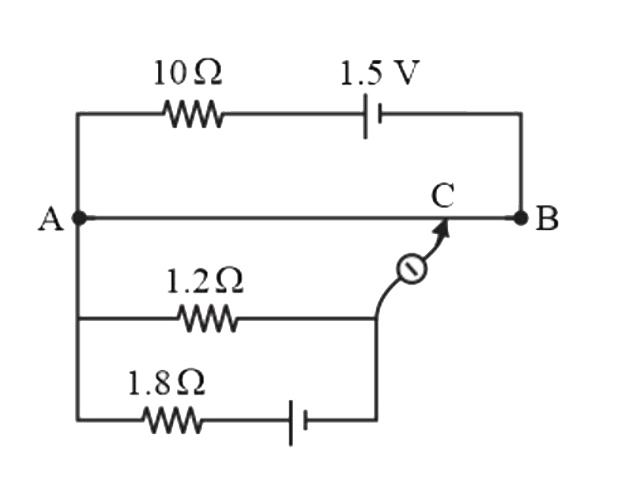The resistance of a metal wire is 10Ω. A current of 30 mA is flowing in it at 20∘C. If p.d. across its ends is constant, then its temperature is increased to 120∘C, then the current flowing in the wire will be in mA(α=5×10−3/0C)
A) 20
B) 15
C) 10
D) 40
The correct Answer is:A
To solve the problem, we will follow these steps:
Step 1: Calculate the potential difference (V) across the wire at 20°C.
According to Ohm's law, the current (I) flowing through a resistor (R) is given by:
I=VR
Given:
- Resistance, R=10Ω
- Current, I=30mA=0.03A
Rearranging the formula to find V:
V=I×R
Substituting the values:
V=0.03A×10Ω=0.3V
Step 2: Determine the new resistance (R') at 120°C.
The resistance of a metal wire changes with temperature according to the formula:
R′=R(1+αΔT)
Where:
- α=5×10−3°C−1
- ΔT=Tf−Ti=120°C−20°C=100°C
Substituting the values:
R′=10Ω×(1+5×10−3×100)
R′=10Ω×(1+0.5)=10Ω×1.5=15Ω
Step 3: Calculate the new current (I') at 120°C.
Using Ohm's law again:
I′=VR′
Substituting the values:
I′=0.3V15Ω
I′=0.02A
Step 4: Convert the current from Amperes to milliamperes.
Since 1A=1000mA:
I′=0.02A×1000=20mA
Final Answer:
The current flowing in the wire at 120°C will be 20 mA.
---
According to Ohm's law, the current (I) flowing through a resistor (R) is given by:
I=VR
Given:
- Resistance, R=10Ω
- Current, I=30mA=0.03A
V=I×R
Substituting the values:
V=0.03A×10Ω=0.3V
The resistance of a metal wire changes with temperature according to the formula:
R′=R(1+αΔT)
Where:
- α=5×10−3°C−1
- ΔT=Tf−Ti=120°C−20°C=100°C
R′=10Ω×(1+5×10−3×100)
R′=10Ω×(1+0.5)=10Ω×1.5=15Ω
Using Ohm's law again:
I′=VR′
Substituting the values:
I′=0.3V15Ω
I′=0.02A
Since 1A=1000mA:
I′=0.02A×1000=20mA
The current flowing in the wire at 120°C will be 20 mA.
Topper's Solved these Questions
- APPENDICES ( REVISION EXERCISE )BOOK - AAKASH SERIESCHAPTER - APPENDICES ( REVISION EXERCISE )EXERCISE - REVISION EXERCISE (MOVING CHANGES & MEGNETISM)
95 Videos
- APPENDICES ( REVISION EXERCISE )BOOK - AAKASH SERIESCHAPTER - APPENDICES ( REVISION EXERCISE )EXERCISE - REVISION EXERCISE (MAGNETISM AND MATTER )
52 Videos
- APPENDICES ( REVISION EXERCISE )BOOK - AAKASH SERIESCHAPTER - APPENDICES ( REVISION EXERCISE )EXERCISE - REVISION EXERCISE (ELECTRIC POTENTIAL & CAPACITANCE )
143 Videos
- ALTERNATING CURRENTBOOK - AAKASH SERIESCHAPTER - ALTERNATING CURRENTEXERCISE - EXERCISE - III
24 Videos
- APPENDICES (REVISION EXERCISE)BOOK - AAKASH SERIESCHAPTER - APPENDICES (REVISION EXERCISE)EXERCISE - LAW OF MOTION
128 Videos
Similar Questions
The resistance of a metal wire is 10Ω. A current of 30 mA is flowing in it at 20∘C. If p.d. across its ends is constant, then its temperature is increased to 120∘C, then the current flowing in the wire will be in mA(α=5×10−3/0C)
View SolutionThe resistance of a wire is 10Ω. Its length is increased by 10% by stretching. The new resistance will now be
View Solution
Knowledge Check
The input resistance of a transistor is 1000Ω on charging its base current by 10μA, the collector current increases by 2 mA. If a load resistance of 5kΩ is used in the circuit, the voltage gain of the amplifier is
A100B500C1000D1500
How will the sensitivity of a potentiometer change with increase in current flowing through its wire?
View SolutionThe length of the potentiometer wire is 600 cm and a current of 40 mA is flowing in it. When a cell of emf 2 V and internal resistance 10Ω is balanced on this potentiometer the balance length is found to be 500 cm. The resistance of potentiometer wire will be
View SolutionResistance of a metal wire of length 1 m is 26Ω at 20∘C. If the diameter of the wire is 0.3mm, what will be the resistivity of the metal at that temperature ? .
View SolutionIn the below circuit , AB is a wire of length 100 cm with 5Ω resistance . If there is no deflection in the galvanometer , the current flowing in the wire AB is

View SolutionIf specific resistance of a potentiometer wire is 10–7Ωm, the current flow through it is 0.1A and the cross-sectional area of wire is 10–6m2 then potential gradient will be
View SolutionIn a conductor, 6.25×1016 electrons flow from its end A to B in 2 s. Find the current flowing through the conductor.(e=1.6×10−19C)
View SolutionFind the potential difference required to flow a current of 200 mA in a wire of resistance 20Ω.
View Solution
